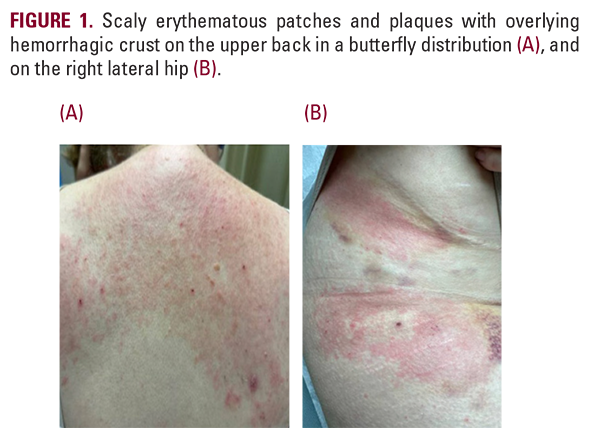CASE REPORT
A 66-year-old woman with vulvar lichen sclerosis, Raynaud's phenomenon, and biliary colic status-post cholecystectomy presented for an intensely pruritic rash ongoing for several months. The eruption affected her right ankle, upper back, extensor elbows, and suprapubic area (Figure 1). She also reported mild gastrointestinal reflux. Prior to dermatology evaluation, she completed 3 prednisone courses, with persistent or recurrent symptoms. Topical steroids, antihistamines, and empiric scabies treatments were also ineffective. Family history included renal cell carcinoma (father) and bullous pemphigoid (mother).

Punch biopsies of the back and thigh showed superficial and mid-dermal perivascular lymphocytic infiltrate with rare eosinophils (Figure 2A, 2B). Periodic Acid-Schiff (PAS) stain was negative for fungi or basement membrane thickening, and Alcian blue showed no significant mucin. Direct immunofluorescence revealed speckled dust-like IgG in the epidermis, suggesting circulating autoantibodies (Figure 2C).
A rheumatology workup for chronic fatigue revealed positive ANA (1:320, nuclear pattern) and anti-centromere antibodies (>8.0 units). Further serologic testing was negative for deamidated gliadin peptide, tissue transglutaminase antibodies, C3/C4, BP180/BP230, ANCAs, RF, CCP, dsDNA, SPEP, Ro, La, Sm, RNP, and TPO, but positive for smooth muscle antibodies (1:80) and antimitochondrial antibodies (AMA; 122.2).
She was diagnosed with primary biliary cholangitis (PBC) with limited systemic sclerosis (CREST syndrome) and referred to gastroenterology for an endoscopy and liver biopsy. The liver ultrasound showed hyperechogenicity and mild hepatomegaly. Despite starting ursodeoxycholic acid (50 mg/kg/day) and cholestyramine, the pruritus continued to persist even in setting of adjunct and maximally titrated topical steroids, gabapentin, and antihistamines. Eventually, monotherapy with upadacitinib 30 mg daily led to significant pruritus reduction. Within 3 weeks, she reported 95% reduction in itch severity via POEM scores. Liver markers normalized after 3 months (Table 1).
A rheumatology workup for chronic fatigue revealed positive ANA (1:320, nuclear pattern) and anti-centromere antibodies (>8.0 units). Further serologic testing was negative for deamidated gliadin peptide, tissue transglutaminase antibodies, C3/C4, BP180/BP230, ANCAs, RF, CCP, dsDNA, SPEP, Ro, La, Sm, RNP, and TPO, but positive for smooth muscle antibodies (1:80) and antimitochondrial antibodies (AMA; 122.2).
She was diagnosed with primary biliary cholangitis (PBC) with limited systemic sclerosis (CREST syndrome) and referred to gastroenterology for an endoscopy and liver biopsy. The liver ultrasound showed hyperechogenicity and mild hepatomegaly. Despite starting ursodeoxycholic acid (50 mg/kg/day) and cholestyramine, the pruritus continued to persist even in setting of adjunct and maximally titrated topical steroids, gabapentin, and antihistamines. Eventually, monotherapy with upadacitinib 30 mg daily led to significant pruritus reduction. Within 3 weeks, she reported 95% reduction in itch severity via POEM scores. Liver markers normalized after 3 months (Table 1).






